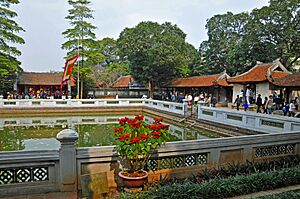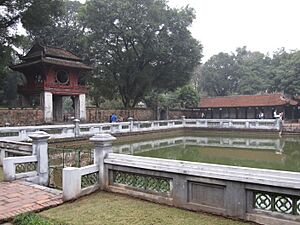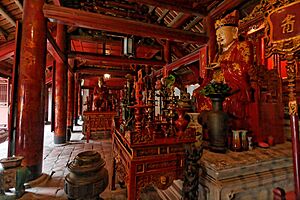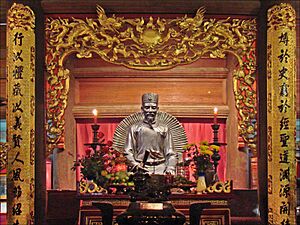Temple of Literature, Hanoi facts for kids
Văn Miếu (Vietnamese: Văn Miếu), also known as the Temple of Literature, is a special place in Hanoi, northern Vietnam. It's a temple built to honor Confucius, a famous Chinese teacher and philosopher.
The temple was first built in 1070 by Emperor Lý Thánh Tông. It was also home to the Imperial Academy, which was Vietnam's very first national university. This university taught students from 1076 to 1779.
Quick facts for kids Temple of Confucius |
|
|---|---|
|
Văn Miếu
|
|
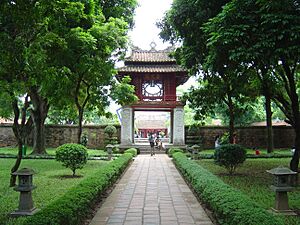
Second Courtyard and Khuê Văn pavilion
|
|
| Religion | |
| Affiliation | Confucianism |
| Location | |
| Location | Hanoi |
| Architecture | |
| Date established | 1070 |
Văn Miếu is one of several temples in Vietnam that honor Confucius, wise people, and scholars. It is located south of the Imperial Citadel of Thăng Long. The temple has many buildings, statues, and stone tablets. These were places for ceremonies, study, and important exams for the Đại Việt kingdom.
You can even see the temple on the back of the 100,000 Vietnamese đồng banknote! Before the Tết Vietnamese New Year, artists who specialize in calligraphy gather here. They write wishes in Chữ Hán (old Vietnamese script) as gifts or decorations.
Contents
History of the Temple
The Văn Miếu was first built in 1070. It was rebuilt many times over the years, including during the Trần dynasty (1225–1400). Even after wars and disasters, the temple has kept its old building styles and valuable items. Big restoration projects happened in 1920, 1954, and 2000.
In 1070, during the rule of King Lý Thánh Tông, the Văn Miếu was built. Statues of Confucius and his four best students were carved. These students were Yan Hui, Zengzi, Zisi, and Mencius. Also, 72 other statues of Confucian scholars were painted. Special ceremonies were held for them four times a year. The king's sons, called Crown Princes, also studied here.
Vietnam's First University
In 1076, Vietnam's first university was created inside the temple. It was called "Quốc Tử Giám" or the Imperial Academy. Emperor Lý Nhân Tông started it to educate important people. These included government officials, nobles, and even members of the royal family. The university was open for a long time, from 1076 to 1779.
In 1802, the Nguyễn dynasty moved the capital to Huế. They built a new imperial academy there. Because of this, the academy at the Hanoi temple became less important. It turned into a local school.
During the time of French Indochina, the Văn Miếu - Quốc Tử Giám was officially recognized as a historic monument in 1906. Between 1945 and 1954, some parts of the temple were taken down by the French. This was to make more space for the Saint Paul Hospital during wartime. However, efforts to restore the temple were made in 1920 and 1947.
Temple Layout
The temple's design is similar to the temple in Qufu, China, where Confucius was born. It covers a large area, including Văn lake, Giám park, and several courtyards. A brick wall surrounds the inner parts.
In front of the main gate, there are four tall pillars. On each side of these pillars, there are two stone tablets. These tablets told horsemen to get off their horses before entering.
The main gate leads to three pathways. The middle path was only for the monarch (the king or emperor). Above this path, there is a large bronze bell. The path on the left was for government officials, and the path on the right was for military officials.
The temple area is divided into five courtyards. The first two courtyards are peaceful areas with old trees and neat lawns. Scholars would relax here, away from the busy world outside.
The bronze bell above the main gate was added in the 1800s. It was rung to announce that an important person was entering. Only monks were allowed to touch it. The bell has patterns of a phoenix, which means beauty, and a dragon, which means power. These symbols represent the Emperor and Queen. You can find a bell in all pagodas (temples) in Vietnam.
First Courtyard
The first courtyard starts at the Great Portico (the main entrance). It goes up to the Đại Trung gate, which has two smaller gates on its sides: the Đạt Tài gate and the Thành Đức gate.
Second Courtyard
The second courtyard is known as the great central courtyard. It has the Khuê Văn pavilion, a special building from 1805. This pavilion is a symbol of Hanoi today.
The Khuê Văn pavilion stands on four white stone pillars. It has a red roof with two round windows and fancy decorations. Inside, a bronze bell hangs, which is rung for special events. Many old poems on the pavilion celebrate Vietnamese culture. Next to the Khuê Văn pavilion are the Súc Văn gate and the Bi Văn gate. These gates are dedicated to the beauty of writing. In the first and second courtyards, you can see topiaries. These are bushes cut into shapes of the 12 zodiac animals.
Third Courtyard
You enter the third courtyard from the Khuê Văn pavilion. In this courtyard, you'll find the Thiên Quang well. On each side of the well, there are two large halls. These halls store valuable items from the temple.
Doctor's Stone Tablets
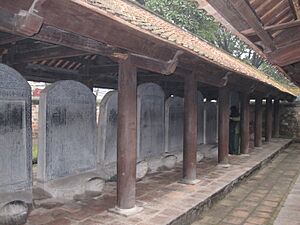
The building of these stone tablets started in 1484 under Emperor Lê Thánh Tông. He put up 116 stone tablets carved on blue stone turtles. These tablets were made to honor smart people and encourage studying. The turtle (Quy) is one of Vietnam's four holy creatures. The others are the Dragon, the Unicorn, and the Phoenix. The turtle represents long life and wisdom. The turtles' shapes and sizes changed over time.
There are 82 stone tablets left today. They list the names and birthplaces of 1307 students who passed 82 royal exams between 1442 and 1779. The old Chinese writings on each tablet praise the king and explain why the exams were held. They also list the officials who organized the exams. People used to rub the stone turtles' heads for good luck. Now, there's a fence to protect them.
These tablets are important for learning about Vietnam's culture, education, and art. In 2011, the tablets were added to UNESCO's Memory of the World Register.
Fourth Courtyard
You enter the fourth courtyard through the Đại Thành gate. On each side, there are two smaller gates: Kim Thanh gate and Ngọc Chấn gate. This courtyard is the main area for ceremonies.
On each side of this ceremonial courtyard, there are two halls. They used to hold altars for Confucius's 72 most honored students and for Chu Văn An, a former head of the Imperial Academy. In the middle of the fourth courtyard is the House of Ceremonies (Đại Bái Đường). The next building is the Thượng Điện. Here, Confucius and his four closest students (Yanhui, Zengshen, Zisi, and Mencius) are honored. The sanctuary also has altars for ten other important philosophers. These buildings show the style of the early 1800s. A small museum displays ink wells, pens, books, and personal items that belonged to some of the students.
Fifth Courtyard: The Imperial Academy
In 1077, Emperor Lý Nhân Tông ordered the building of an imperial academy as a fifth courtyard. Smart officials were chosen to be students here. In 1236, the academy was made bigger and called Quốc Tử Viện. Later, it was called Quốc Học Viện.
During the Lê dynasty, it was called Thái Học Viện and grew even more. This included the Minh Luân house, classrooms, a storage area for wooden printing blocks, and two sets of dormitories (each with 25 rooms). The Khải Thánh shrine was built to honor Confucius's parents.
In 1946, the courtyard was destroyed during the First Indochina War. In 2000, the fifth courtyard was rebuilt on the same spot as the original "Imperial Academy." It celebrates Vietnam's talented people, traditions, culture, and education.
The new fifth courtyard was designed to match the traditional architecture and the temple's surroundings. Several buildings were constructed, including a front building, a rear building, side buildings, a bell house, and a drum house. The Thái Học courtyard covers 1530 square meters of the temple's total area of 6150 square meters.
The front building has several uses. Ceremonies honoring cultural scholars are held here, as well as scientific and cultural events. The rear building has two levels. The ground floor has a statue of Chu Văn An (a former head of the academy). It also shows exhibits about the temple and the academy, with information on Confucian education in Vietnam.
The upper floor is dedicated to the three kings who helped build the temple and the academy the most:
- Lý Thánh Tông (1023–1072), who founded the temple in 1070.
- Lý Nhân Tông (1066–1127), who founded the Imperial Academy.
- Lê Thánh Tông (1442–1497), who ordered the stone tablets for the doctors in 1484.
On each side of the rear building, there are square buildings. One holds a drum, and the other holds a bronze bell. The drum is 2.01 meters wide and 2.65 meters high. It weighs 700 kilograms. The bell was made in 2000 and measures 2.1 by 0.99 meters.
Studying at the Imperial Academy
Teaching and learning at the Imperial Academy began in 1076 under the Lý dynasty. It grew even more in the 1400s under the Le dynasty. The academy was led by a rector (Tế tửu) and a vice-rector (Tư nghiệp). The professors had different titles like Giáo thụ and Bác sĩ.
Many students lived and studied at the temple. Most students (Giám sinh) had already passed a regional exam (Hương Examination) before joining the academy. At the academy, students discussed literature and wrote poetry. They learned Chinese, Chinese philosophy, and Chinese history. Their textbooks were printed on paper in both Chinese and Vietnamese.
They read important books like "The Four Books" and "Five Pre-Confucian Classics." These included "The Great Learning", "Doctrine of the Mean", "The Analects", "Mencius", "Classic of Poetry", "Book of Documents", "Book of Rites", "Book of Change", and "Spring and Autumn Annals". They also studied ancient poetry and Chinese history.
Students usually studied for three to seven years. They had small tests every month and four big tests each year. If they passed these tests, they could take the national exam (Hội Examination). Passing the Hội Examination allowed them to take the royal exam, called the Đình Examination. This final exam was held at the royal court. The king himself asked the questions, listened to the students' answers, and then ranked those who passed. The Imperial Academy was the biggest learning center in the country.
Images for kids
See also
- Confucian examination system in Vietnam
- Văn Miếu Trấn Biên in Đồng Nai, Vietnam
- Literary Chinese in Vietnam


